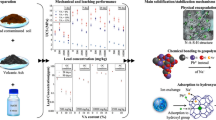Abstract
The treatment of smectites with a hydroxy-Al polymer produced chemically modified clays that had much greater affinities for chlorinated dioxins and biphenyls than untreated clays. For hydroxy-Al-treated kaolinite, the high affinity for chlorinated dioxins is thought to have arisen from an interaction between the hydroxy-Al polymer bound to the clay and the chlorinated dioxin in solution. Thus, the adsorption of dioxins from aqueous solution by hydroxy-Al-treated clays is similar to the adsorption of reactants from the gas phase by metals supported on mineral oxides during catalysis. In both systems, the essentially inert mineral oxide support effectively disperses the active adsorptive agent. At the concentrations of octachlorodioxin used in this study (≤5 ppb), hydroxy-Al-montmorillonite had a distribution coefficient of 90,000 (ml/g), corresponding to about 95% removal efficiency of the dioxin from solution per batch. For hexachlorohiphenyl, the distribution coefficient was 30,000 (ml/g), and the removal efficiency was 85%.
Similar content being viewed by others
References
Boyd, S. A. and Mortland, M. M. (1985) Dioxin radical formation and polymerization on Cu(II)-smectite: Nature 316, 532–535.
Fogler, H. S. and Srinivasan, K. R. (1986) Use of clay-based adsorbents for the removal of chlorinated dioxins and biphenyls from industrial wastewaters: in Proc. The Third World Congress of Chemical Engineering, Vol. 3, Tokyo, Japan, Soc. Chem. Eng. Japan, Tokyo, 623–626.
Friesan, K. J., Sarna, L. P., and Webster, G. R. B. (1985) Aqueous solubility of polychlorinated dibenzo-p-dioxins determined by high pressure liquid chromatography: Chemosphere 14, 1267–1274.
Gibbons, J. J. and Soundararajan, R. (1988) The nature of chemical bonding between modified clay minerals and organic waste materials: American Laboratory 20, 38–46.
Horzempa, L. M. and DiToro, D. M. (1983) The extent of reversibility of polychlorinated biphenyl adsorption: Water Res. 17, 851–859.
Hutzinger, S., Safe, S., and Zitko, V. (1974) The Chemistry of PCB’s: CRC Press, Boca Raton, Florida, 269 pp.
Jackson, D. R., Roulier, M. H., Grotta, H. M., Rust, S. W., and Warner, J. S. (1986) Solubility of 2, 3, 7, 8-TCDD in contaminated soils: in Chlorinated Dioxins and Dibenzofurans in Perspective, C. Rappe, G. Choudary, and I. H. Keith, eds., Lewis Publishers, Chelsea, Michigan, 185–200.
Karickhoff, S. W., Brown, D. S., and Scott, T. A. (1979) Sorption of hydrophobic pollutants on natural sediments: Water Res. 13, 241–248.
Kende, A. S., Wade, J. J., Ridge, D., and Poland, A. (1974) Synthesis and fourier transform carbon-13 NMR spectroscopy of new toxic polyhalodibenzo-p-dioxins: J. Org. Chem. 39, 931–937.
Lahav, N., Shani, U., and Shabtai, J. (1978) Cross-linked smectites. I. Synthesis and properties of hydroxy-aluminum-montmorillonite: Clays & Clay Minerals 26, 107–115.
Miller, G., Sontum, S., and Crosby, D. G. (1977) Electron-acceptor properties of chlorinated dibenzo-p-dioxins: Bull. Environ. Contamination & Toxicology 18, 611–616.
Misra, C. (1986) Industrial Alumina Chemicals: ACS Monograph 184, American Chemical Society, Washington, D.C., 73–95.
Nolan, T. (1988) Dioxin removal from aqueous solution by clays and hydroxy aluminum polymers: Ph.D. thesis, Univ. Michigan, Ann Arbor, Michigan, 187 pp.
Oades, J. M. (1984) Interaction of polycations of aluminum and iron with clay: Clays & Clay Minerals 32, 49–57.
Pinnavaia, T. J. (1983) Intercalated clay catalysts: Science 220, 366–371.
Pinnavaia, T. J., Tzou, M.-S., Landau, S. D., and Raythatha, R. H. (1984) On the pillaring and delamination of smectite clay catalysts by polyoxo cations of Al: J. Mol. Catalysis 27, 195–212.
Rapaport, R. A. and Eisenreich, S. (1984) Chromatographic determination of octanol-water partition coefficients (Kow’s) for 58 polychlorinated biphenyl congeners: Environ. Sci. Technol. 18, 163–170.
Rengasamy, P. and Oades, J. M. (1978) Interaction of monomelic and polymeric species of metal ions with clay surfaces: III. Al(III) and Cr(III): Aust. J. Soil Res. 16, 53–66.
Rice, A. P. (1982) Seveso accident: Dioxin: in Hazardous Materials Spills Handbook, G. F. Bennett, F. S. Feates, and I. Wilder, eds., McGraw-Hill, New York, 11–44.
Schroy, J.M., Hileman, F.D., and Cheng, S.C. (1985) Physical/chemical properties of 2, 3, 7, 8-TCDD: Chemosphere 14, 877–880.
Shaw, G. R. and Connell, D. W. (1980) Relationships between steric factors and bioconcentration of polychlorinated biphenyls (PCB’s) by the sea mullet: Chemosphere 9, 731–742.
Srinivasan, K. R. and Fogler, H. S. (1986a) Preparation and characterization of clay-based sorbents for the removal of trace levels of 2, 3, 7, 8-TCDD from industrial wastewater: in Chlorinated Dioxins and Dibenzofurans in Perspective, C. Rappe, G. Choudary, and L. H. Keith, eds., Lewis Publishers, Chelsea, Michigan, 519–530.
Srinivasan, K. R. and Fogler, H. S. (1986b) Binding of OCDD, 2, 3, 7, 8-TCDD, and HCB on clay-based sorbents: in Chlorinated Dioxins and Dibenzofurans in Perspective, C. Rappe, G. Choudary, and L. H. Keith, eds., Lewis Publishers, Chelsea, Michigan, 531–540.
Srinivasan, K. R., Fogler, H. S., Gulari, E., Nolan, T., and Schultz, J. S. (1985) The removal of trace levels of dioxins from water by sorption on modified clay: Environmental Progress 4, 239–245.
Tzou, M.-S. (1983) Clay catalysts pillared by metal hydroxy polymers: Ph.D. thesis, Michigan State University, East Lansing, Michigan, 188 pp.
van Olphen, H. and Fripiat, J. J. (1979) Data Handbook for Clay Materials and other Non-Metallic Minerals: Pergamon Press, New York, 265 pp.
Weber, W. J., Jr., Voice, T. C, Pibazari, M., Hunt, G. E., and Ulanoff, D. M. (1983) Sorption of hydrophobic compounds by sediments, soils and suspended solids—II: Water Res. 10, 1443–1452.
Author information
Authors and Affiliations
Rights and permissions
About this article
Cite this article
Nolan, T., Srinivasan, K.R. & Fogler, H.S. Dioxon Sorption by Hydroxy-Aluminum-Treated Clays. Clays Clay Miner. 37, 487–492 (1989). https://doi.org/10.1346/CCMN.1989.0370515
Received:
Accepted:
Published:
Issue Date:
DOI: https://doi.org/10.1346/CCMN.1989.0370515




